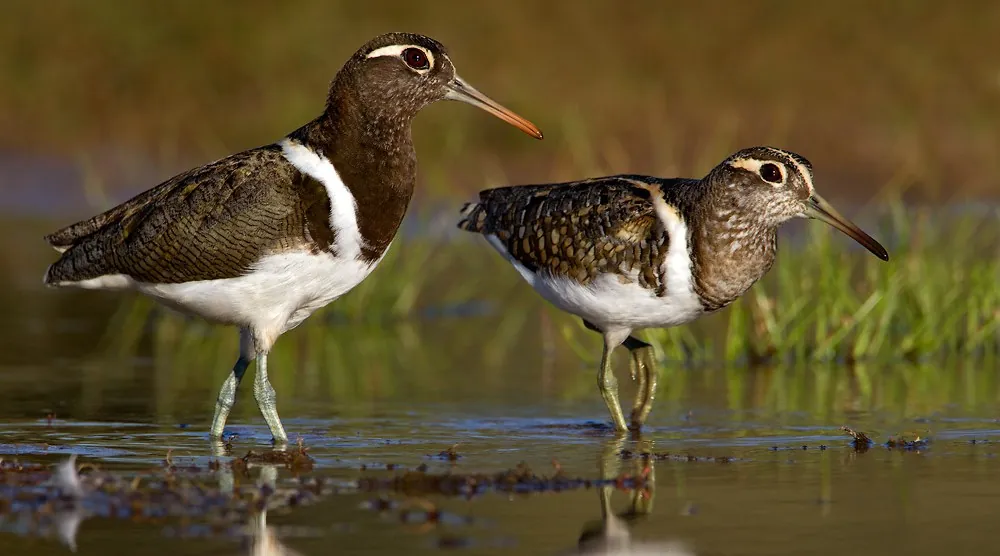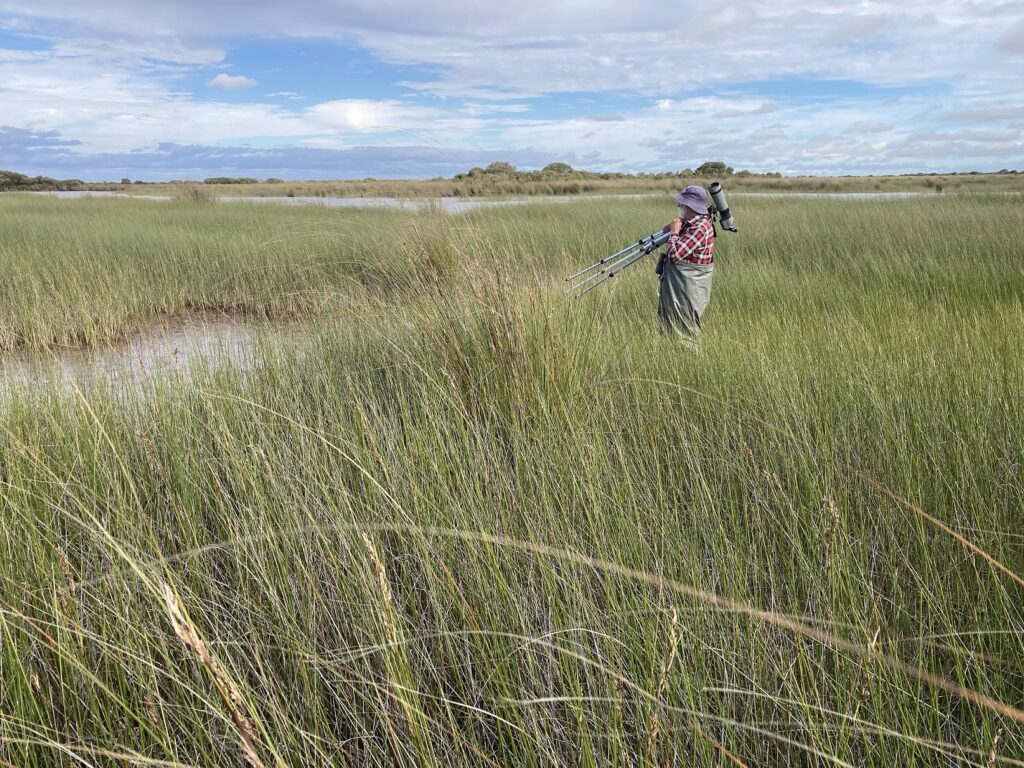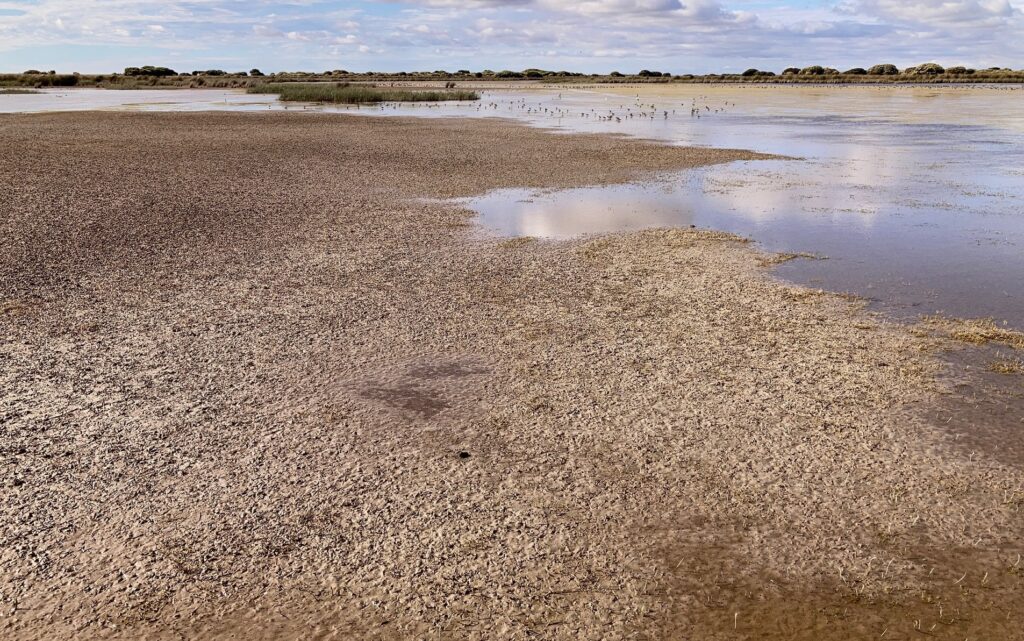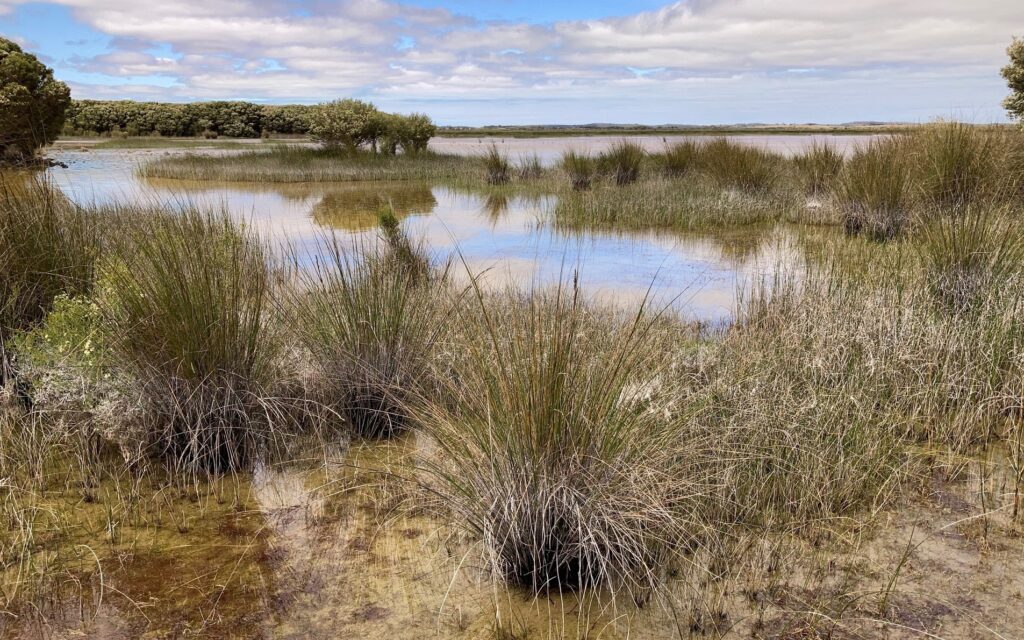Painted Snipe, Freckled Duck and more – spring waterbird survey highlights the importance of Lake Hawdon North
In previous blogs we have introduced readers to Lake Hawdon North, a 2,500 ha wetland located about 15 km inland from Robe in the South East of SA. This seasonal wetland of fresh-brackish habitats is proposed for hydrological restoration (to reduce the impacts of artificial drainage on its water regime), and NGT have designed and implemented an ecological monitoring program. The monitoring will enable the future outcomes of restoration to be measured against a baseline.
In November 2023, with support from Friends of Shorebirds South East (FoSSE) and the SA Department for Environment and Water (DEW), NGT undertook the third consecutive baseline (pre-restoration) spring waterbird survey of the wetland. Conditions were perfect for fieldwork with light winds and mild temperatures. A large proportion of Lake Hawdon North was dry, but where water persisted the habitat was looking fantastic. There was plenty of shallow, open mudflat habitat that is ideal for migratory shorebirds and other waders.
We are still entering the data but waterbird numbers were noticeably higher than last year, including migratory shorebirds, particularly sharp-tailed sandpipers. This illustrates the influence of continental-scale water availability on local waterbird abundance – winter-spring 2023 has been much drier across much of Australia than the same period in 2022. It was exciting to observe some rare and threatened species never before recorded in the area:

Australian painted snipe (Rostratula australis) – Bryan and Cath spotted an individual in shallow water amongst Gahnia filum tussocks. Observations of this widespread but cryptic waterbird are extremely rare and are highly prized by bird watchers. The rest of the team went back to the same location late in the day and were lucky enough to flush a pair. Just a quick glimpse but a big highlight nonetheless.
Photo by Eric Tan – Birdlife Australia
Australasian bittern (Botaurus poiciloptilus) – again it was Bryan and Cath who flushed a bittern from some dense Baumea arthrophylla sedgeland, which is quite extensive in the wetland. This is the first record of this nationally endangered species for Lake Hawdon North, although it has been recorded previously in adjoining Lake Hawdon South. The proposed restoration of Lake Hawdon North is targeting migratory shorebirds, which favour open mudflat habitat, but this find highlights the broad range of species that would benefit, including those that rely upon dense vegetation combined with surface water.
Freckled duck (Stictonetta naevosa) – another Bryan and Cath find, this species is rated is vulnerable in SA and in the South East region and has not previously been recorded in the Lake Hawdon system (North and South combined).
Pacific golden plover (Pluvialis fulva) – Jeff and Holly spotted three of these in shallow water in the far north-east of the survey area. Not often observed in the region, they are migratory and hence listed as a species of national environmental significance – a great find not previously recorded in the Lake Hawdon system.
Glossy ibis (Plegadis falcinellus) – a favourite among waterbird enthusiasts. These nomadic birds, with their dark chocolate-brown iridescent plumage, have been observed previously in Lake Hawdon South but not in Hawdon North. Ben and Vicki spotted a small group in open mudflat habitat and flying overhead.
Baillon’s crake (Porzana pusilla) – Mark, Jono and Abel got a good look at one of these when they flushed it from dense vegetation just a few metres away. The species is the smallest of Australia’s 16 species of crakes and rails (family Rallidae) and has not previously been recorded in the Lake Hawdon system.
Australian spotted crake (Porzana fluminea) – the habitat in Lake Hawdon North is perfect for this cryptic species and they have probably been glimpsed before, but never for long enough to get a confident ID. Another tick for Bryan and Cath but also observed by Mark, Jono and Abel.



The objective of the proposed hydrological restoration project is to retain water in Lake Hawdon North for longer into summer and thereby extend the availability of the wetland as waterbird habitat each year. If restored, the water levels and general habitat conditions we observed in mid-November would likely occur in mid-January. This would increase the ecological value of the wetland because (unlike pre-drainage, pre-European conditions) much of the seasonal wetland habitat in the region (due to regional-scale drainage activities) is now typically dry by mid-late summer, forcing waterbirds to become increasingly dependent upon a shrinking area of available habitat. Hydrological restoration would involve the construction of a regulator on Drain L at the location where it exits Lake Hawdon North near the Woakwine Range. The project is proposed as part of the On-Ground Works Project, a component of the Australian and South Australian Government’s Healthy Coorong, Healthy Basin Program.
Thanks to everyone who participated in the survey: Ben Taylor (NGT), Bryan Haywood (NGT), Jonathan Tuck (NGT), Abel Zevenboom (NGT), Mark de Jong (DEW), Jeff Campbell (FoSSE), Holly Prest (FoSSE), John Mullins (FoSSE), Vicki Natt (FoSSE), Cath Bell (FoSSE) and Emma Blythman (FoSSE).
